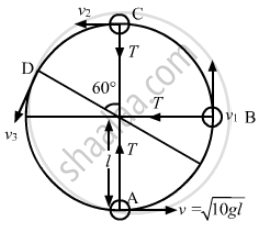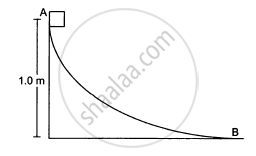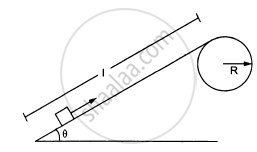Advertisements
Advertisements
प्रश्न
The bob of a pendulum at rest is given a sharp hit to impart a horizontal velocity \[\sqrt{10 \text{ gl }}\], where l is the length of the pendulum. Find the tension in the string when (a) the string is horizontal, (b) the bob is at its highest point and (c) the string makes an angle of 60° with the upward vertical.
उत्तर
(a) Let the velocity at B be \[\text{v}_1\] .
\[\frac{1}{2}\text{ m}\nu^2 = \frac{1}{2}\text{m} v_1^2 + \text{mgl}\]
\[ \Rightarrow \frac{1}{2}\text{m} \left( 10 \text{gl} \right) = \frac{1}{2}\text{m} \nu_1^2 + \text{mgl}\]
\[ \nu_1^2 = 8 \text{gl}\]

So, the tension in the string at the horizontal position,
\[\text{ T }= \frac{\text{ m} \nu^2}{\text{ R}} = \text{ m }\frac{8 \text{ gl} }{\text{l}}\]
\[ = 8 \text{mg}\]
(b) Let the velocity at C be \[\text{v}_2\] .
\[\frac{1}{2}\text{ m }\nu^2 = \frac{1}{2}\text{ m }\nu_2^2 + \text{ mg (2l)}\]
\[\Rightarrow \frac{1}{2}\text{m} 10 \text{ gl } = \frac{1}{2}\text{ m }\nu_2^2 + 2\text{ mgl }\]
\[ \Rightarrow \nu_2^2 = 6 \text{ gl }\]
So, the tension in the string is given by \[T_C = \frac{\text{mv}_2^2}{\text{l}} - \text{mg = 5 mg}\]
(c) Let the velocity at point D be \[\nu_4\] .
Again,
\[\frac{1}{2}\text{m} \nu^2 = \frac{1}{2}\text{m} \nu_3^2 + \text{mgl} \left( 1 + \cos 60^\circ\right)\]
\[ \Rightarrow \nu_3^2 = 7 \text{gl}\]
So, the tension in the string,
\[\text{T}_\text{D} = \frac{\text{m} \nu_3^2}{\text{l}} - \text{mg} \cos 60^\circ\]
\[ = \text{m}\frac{\left( 7 \text{gl} \right)}{\text{l}} - 0 . 5 \text{mg}\]
\[ = 7 \text{ mg - 0 . 5 mg }\]
\[ = 6 . 5 \text{ mg}\]
APPEARS IN
संबंधित प्रश्न
A ball is given a speed v on a rough horizontal surface. The ball travels through a distance l on the surface and stops. What is the work done by the kinetic friction?
Consider the situation of the previous question from a frame moving with a speed v0 parallel to the initial velocity of the block. (a) What are the initial and final kinetic energies? (b) What is the work done by the kinetic friction?
A water pump lifts water from 10 m below the ground. Water is pumped at a rate of 30 kg/minute with negligible velocity. Calculate the minimum horsepower that the engine should have to do this.
An unruly demonstrator lifts a stone of mass 200 g from the ground and throws it at his opponent. At the time of projection, the stone is 150 cm above the ground and has a speed of 3 m/s. Calculate the work done by the demonstrator during the process. If it takes one second for the demonstrator to lift the stone and throw it, what horsepower does he use?
A scooter company gives the following specifications about its product:
Weight of the scooter − 95 kg
Maximum speed − 60 km/h
Maximum engine power − 3⋅5 hp
Pick up time to get the maximum speed − 5 s
Check the validity of these specifications.
A block of mass 100 g is moved with a speed of 5⋅0 m/s at the highest point in a closed circular tube of radius 10 cm kept in a vertical plane. The cross-section of the tube is such that the block just fits in it. The block makes several oscillations inside the tube and finally stops at the lowest point. Find the work done by the tube on the block during the process.
A small block of mass 200 g is kept at the top of a frictionless incline which is 10 m long and 3⋅2 m high. How much work was required (a) to lift the block from the ground and put it an the top, (b) to slide the block up the incline? What will be the speed of the block when it reaches the ground if (c) it falls off the incline and drops vertically to the ground (d) it slides down the incline? Take g = 10 m/s2.
A block weighing 10 N travels down a smooth curved track AB joined to a rough horizontal surface (In the following figure). The rough surface has a friction coefficient of 0⋅20 with the block. If the block starts slipping on the track from a point 1⋅0 m above the horizontal surface, how far will it move on the rough surface?

A block of mass 250 g is kept on a vertical spring of spring constant 100 N/m fixed from below. The spring is now compressed 10 cm shorter than its natural length and the system is released from this position. How high does the block rise ? Take g = 10 m/s2.
A simple pendulum consists of a 50 cm long string connected to a 100 g ball. The ball is pulled aside so that the string makes an angle of 37° with the vertical and is then released. Find the tension in the string when the bob is at its lowest position.
Following figure following shows a smooth track, a part of which is a circle of radius R. A block of mass m is pushed against a spring of spring constant k fixed at the left end and is then released. Find the initial compression of the spring so that the block presses the track with a force mg when it reaches the point P, where the radius of the track is horizontal.

A particle slides on the surface of a fixed smooth sphere starting from the topmost point. Find the angle rotated by the radius through the particle, when it leaves contact with the sphere.
Figure ( following ) shows a smooth track which consists of a straight inclined part of length l joining smoothly with the circular part. A particle of mass m is projected up the incline from its bottom. Find the minimum projection-speed \[\nu_0\] for which the particle reaches the top of the track.

A chain of length l and mass m lies on the surface of a smooth sphere of radius R > l with one end tied to the top of the sphere. Find the gravitational potential energy of the chain with reference level at the centre of the sphere.
A chain of length l and mass m lies on the surface of a smooth sphere of radius R > l with one end tied to the top of the sphere. Suppose the chain is released and slides down the sphere. Find the kinetic energy of the chain, when it has slid through an angle θ.
A bullet of mass m fired at 30° to the horizontal leaves the barrel of the gun with a velocity v. The bullet hits a soft target at a height h above the ground while it is moving downward and emerges out with half the kinetic energy it had before hitting the target.
Which of the following statements are correct in respect of bullet after it emerges out of the target?
- The velocity of the bullet will be reduced to half its initial value.
- The velocity of the bullet will be more than half of its earlier velocity.
- The bullet will continue to move along the same parabolic path.
- The bullet will move in a different parabolic path.
- The bullet will fall vertically downward after hitting the target.
- The internal energy of the particles of the target will increase.
Give example of a situation in which an applied force does not result in a change in kinetic energy.
A raindrop of mass 1.00 g falling from a height of 1 km hits the ground with a speed of 50 ms–1. Calculate
- the loss of P.E. of the drop.
- the gain in K.E. of the drop.
- Is the gain in K.E. equal to a loss of P.E.? If not why.
Take g = 10 ms–2
Suppose the average mass of raindrops is 3.0 × 10–5 kg and their average terminal velocity 9 ms–1. Calculate the energy transferred by rain to each square metre of the surface at a place which receives 100 cm of rain in a year.
